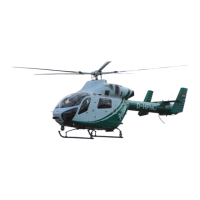
Do you have a question about the MD Helicopters MD900 with PW206E and is the answer not in the manual?
| Brand | MD Helicopters |
|---|---|
| Model | MD900 with PW206E |
| Category | Toy |
| Language | English |
Defines passenger capacity, crew requirements, and rules for doors off/open flight.
Specifies operating conditions, temperature limits, and icing/cabin heat rules.
Presents the VNE chart and its variations with altitude and temperature.
Defines maximum gross weight, minimum flying weight, and cargo capacities.
Illustrates the longitudinal and lateral CG limits for safe operation.
Defines limits for torque, EGT, NP, and NG, including overspeed and overtemperature.
Lists acceptable fuel types and conditions for operation.
Details procedures for single engine failure and low rotor RPM warning.
Provides procedures for water landings in dual engine failure and OEI/AEO conditions.
Describes procedures for critical and non-critical EEC faults and manual control.
Covers procedures for cabin fire/smoke and electrical fires.
Addresses anti-torque failures and VSCS failures.
Outlines checks for standard configuration and optional equipment.
Step-by-step exterior checks for the first flight of the day.
Details cockpit checks for electrical power off and on states before engine start.
Describes the automatic engine start procedure, including GPU use.
Checks to be performed before commencing takeoff.
Chart showing indicated airspeed for best rate of climb at given density altitudes.
Charts showing climb/descent rates at max continuous OEI power for various weights.
Charts showing climb rates at twin engine MCP for various weights.
Charts for maximum hover weight capability in IGE/OGE conditions.
Charts for hover performance in OEI conditions with headwind credit.
Illustrates combinations of airspeed/altitude to be avoided during operations.
Procedure for determining engine capability using automated IIDS checks.
Procedure for manual engine power checks using engine torque and EGT charts.
Defines maximum weights, CG limits, and cargo capacities.
Determines gross weight and longitudinal CG for passenger loading.
Determines gross weight and longitudinal CG for cargo loading.
Emphasizes imperative lateral CG control and permissible internal loadings.
Explains control inputs for cyclic, collective, anti-torque, and VSCS subsystems.
Details the twin PW206E engines, mounting, and air inlet system.
Details the IIDS for monitoring parameters, displays, and Built-in-Test (BIT).
Describes helicopter manual moving and towing procedures.
Locations of servicing points and lists of acceptable fuels and materials.
Describes the fire extinguishing system components and emergency procedures.
Allows operation at gross weights from above 6250 up to 6500 pounds.
Defines maximum airspeed (VNE) and VNE placard.
Specifies maximum gross weight and CG limits.
